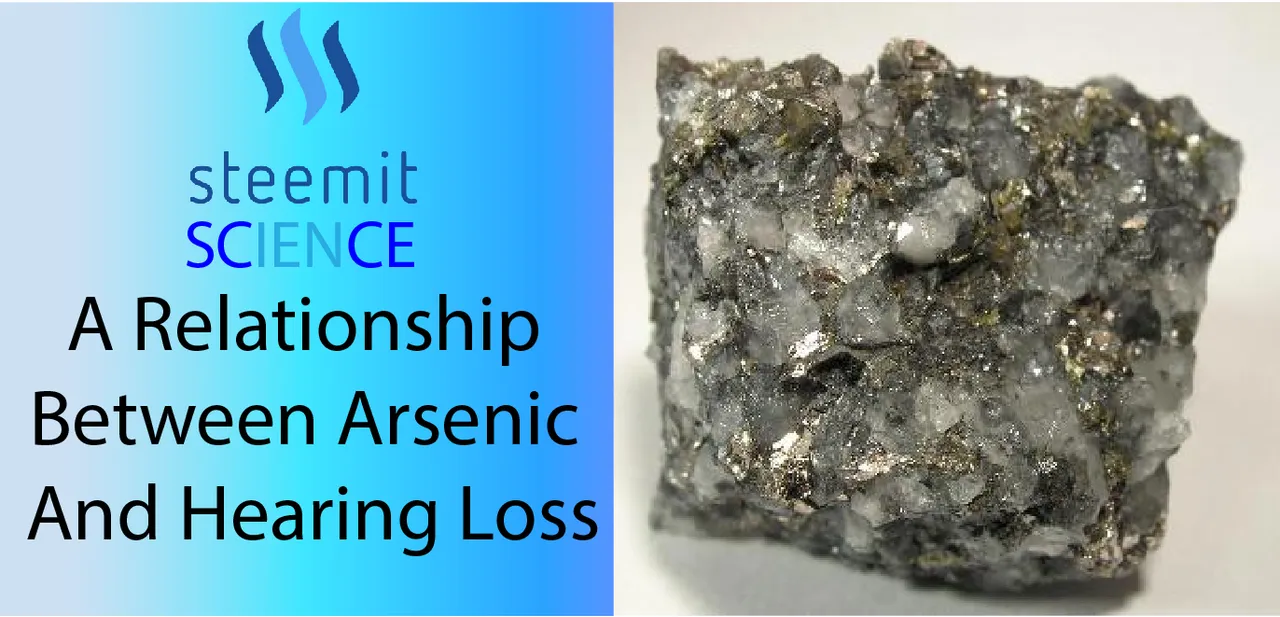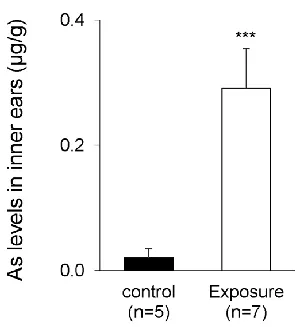We all know that various heavy metals are not good for us to consume right? We are well educated on the issues that can arise from say lead poisioning (which the poor people living in Flint Michigan, USA still have to deal with.) So perhaps the research we will briefly discuss today won't come to much of a surprise to you.
Today we discuss the metal arsenic, and we discuss it in relation to some new research published in the journal Nature: Scientific Reports titled "Oral exposure to arsenic causes hearing loss in young people aged 12–29 years and in young mice." This article caught my eye, because hearing loss is not something I would associate with metal poisoning. So why don't we take a brief swim through this literature (maybe we will get a little knowledge poisoning during the process).

Arsenic Exposure
You may be surprised to know that exposure to Arsenic is actually quite common across the world, with more than 137 millioin people from 70 different countries regularly exposed. [2] This exposure can occur through a variety of pathways, but the most common one is through drinking water. [3] Long ago, a study showed that children who lived in an area with higher arsenic levels in the drinking water developed hearing loss. [4] However, no study had ever been done to truly examine whether there was an associative link between the hearing loss in young people and the arsenic.
Where Might The Hearing Loss Come From?
The authors report that in a guinea pig model, injections of moderate levels of arsenic caused actual physical changes to their inner ears, these changes could very well be the root cause. [5] However these experiments were direct injections, not from exposure due to drinking contaminated water (and may affect the animal entirely differently!)
Studying into the effect of arsenic contaminated drinking water is precisely what the authors set out to do.
What Did They Find?

The authors compared some biological samples from two groups of people, one group which was exposed to tap water containing up to 22 ug/L of arsenic, and a control group which was exposed to tap water containing 0.6 ug/L arsenic. This means the exposure group regularly drank water containing around 36 times more arsenic. As you can see from the plotted data above we can detect the arsenic in their hair, nails and urine. At pretty significant levels too for the exposed group, while the control group not so much.
The authors then went on to looking at how this was associated with their hearing abilities.

What they found is displayed in the figure above. The control group could hear sounds much better (more loudly) then the group of people who had been exposed to the arsenic, with a statistically significant difference between the two groups. The authors performed additional analysis to eliminate bias from sex, age, BMI, whether or not they smoked etc.
However the association between the exposure to arsenic and hearing loss remained.
Does Consuming Water With High Arsenic Levels Cause Accumulation Of The Metal In The Inner Ear?
One of the questions the authors set out to address, was whether drinking water with arsenic in it causes the metal to accumulate in the inner ear. If you recall from above, this accumulation was previously identified as a potential cause for hearing loss in a guinea pig model. So the authors here turned to another rodent model, our old mouse friends.

What they found is shown above. To make a long story short, the answer is clearly YES. Yes drinking water which is contaminated with arsenic results in accumulation of the metal in the inner ear. Since this accumulation has already been associated with physical changes to the inner ear, this provides further fuel to the fire for the relationship between the arsenic and the hearing loss.
Looking A Bit Deeper

So the authors took things a bit further and exposed the inner ear directly with a lower dose of arsenic (0.3 ug/L) and monitored for any changes upon exposure. What they saw was a bit surprising, they saw that amount of auditory nerves and nerve fibers were reduced due to the exposure to the arsenic. The image you are looking at above is of a swatch of the organ of corti which is the sensitive part of the inner ear. The red color is from an antibody that tags only nerves, and you can see that in the bottom two panels there is much less red, especially the bottom right panel which is after 72 hours of exposure to the arsenic. The bar graphs on the right then allow you to see the relative levels of the nerve fibers and the nerve cells themselves. You can see that the reduction in levels is pretty clear from this figure! This could also contribute to a loss of hearing function from the ears.
TL;DR/Conclusions
Here the authors were trying to look into the thought that hearing loss in young people could occur as a result of exposure to arsenic. They through their data showed that this trend is consistent in humans, and able to be replicated in a mouse model. Exposure to arsenic is associated with a loss of hearing.
This hearing loss maybe related to two factors:
- an accumulation of arsenic in the inner ear causing physical changes to the structure of this part of the ear
- damage to the nerve cells in the inner ear
Heavy metal contamination of drinking water has a potentially serious effect on the health of millions of people around the globe. Hopefully through research such as this, the issues are brought to the surface and better methods can be developed to protect people from the harmful properties of these elements. Clean drinking water for all people on earth is a goal that we should all strive toward.
Sources
- https://www.nature.com/articles/s41598-017-06096-0
- https://www.ncbi.nlm.nih.gov/pubmed/25898228
- https://www.ncbi.nlm.nih.gov/pmc/articles/PMC4186553/
- https://www.ncbi.nlm.nih.gov/pubmed/908319
- https://www.ncbi.nlm.nih.gov/pubmed/1223194
All Non Cited Images Are From Pixabay.com, Flickr.com, Pexels.com, or Wikipedia.com And Are Available For Reuse Under Creative Commons Licenses
Any Gifs Are From Giphy.com and Are Also Available for Use Under Creative Commons Licences
If you like this work, please consider giving me a follow: @justtryme90. I am here to help spread scientific knowledge and break down primary publications in such a way so as to cut through the jargon and provide you the main conclusions in short (well compared to the original articles at least!) and easy to read posts.
SteemSTEM
Secondly, please consider supporting the @steemstem project. SteemSTEM is a community driven project which seeks to promote well written/informative Science Technology Engineering and Mathematics postings on Steemit. The project not only curates STEM posts on the platform through both voting and resteeming, but also re-distributes curation rewards as STEEM Power, to members of Steemit's growing scientific/tech community.
To learn more about the project please join us on steemit.chat (https://steemit.chat/channel/steemSTEM), we are always looking for people who want to help in our quest to increase the quality of STEM (and health) posts on our growing platform, and would love to hear from you!
Finally consider joining the @steemstem voting trail, the project account only votes on STEM related posts, so being a part of the trail will allow you to selectively benefit our growing science and tech community on the platform. We thank you for your support.